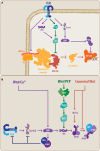Wnt/TLR Dialog in Neuroinflammation, Relevance in Alzheimer's Disease
- PMID: 28286503
- PMCID: PMC5323396
- DOI: 10.3389/fimmu.2017.00187
Wnt/TLR Dialog in Neuroinflammation, Relevance in Alzheimer's Disease
Abstract
The innate immune system (IIS) represents the first line of defense against exogenous and endogenous harmful stimuli. Different types of pathogens and diverse molecules can activate the IIS via a ligand-receptor mechanism. Cytokine release, recruitment of immunocompetent cells, and inflammation constitute the initial steps in an IIS-mediated response. While balanced IIS activity can resolve a harmful event, an altered response, such as deficient or persistent IIS activity, will have a critical effect on organism homeostasis. In this regard, chronic IIS activation has been associated with a wide range of diseases, including chronic inflammatory disorders (inflammatory bowel disease, arthritis, chronic obstructive pulmonary disease, among others), cancer and, more recently, neurodegenerative disorders. The relevance of the immune response, particularly inflammation, in the context of neurodegeneration has motivated rigorous research focused on unveiling the mechanisms underlying this response. Knowledge regarding the molecular hallmarks of the innate immune response and understanding signaling pathway cross talk are critical for developing new therapeutic strategies aimed at modulating the neuroinflammatory response within the brain. In the present review, we discuss the IIS in the central nervous system, particularly the cross talk between the toll-like receptor-signaling cascade and the wingless-related MMTV integration site (Wnt) signaling pathway and its relevance in neurodegenerative disorders such as Alzheimer's disease.
Keywords: Alzheimer’s disease; Wnt signaling; immune response; neuroinflammation; toll-like receptors.
Figures



Similar articles
-
Activation of the Wnt Pathway by Mycobacterium tuberculosis: A Wnt-Wnt Situation.Front Immunol. 2017 Feb 1;8:50. doi: 10.3389/fimmu.2017.00050. eCollection 2017. Front Immunol. 2017. PMID: 28203237 Free PMC article. Review.
-
Innate immunity and neuroinflammation in the CNS: the role of microglia in Toll-like receptor-mediated neuronal injury.Glia. 2010 Feb;58(3):253-63. doi: 10.1002/glia.20928. Glia. 2010. PMID: 19705460 Review.
-
Inflammasome signaling at the heart of central nervous system pathology.J Neurosci Res. 2010 Jun;88(8):1615-31. doi: 10.1002/jnr.22343. J Neurosci Res. 2010. PMID: 20127816 Review.
-
[Frontier of mycobacterium research--host vs. mycobacterium].Kekkaku. 2005 Sep;80(9):613-29. Kekkaku. 2005. PMID: 16245793 Japanese.
-
Intrathecal heat shock protein 60 mediates neurodegeneration and demyelination in the CNS through a TLR4- and MyD88-dependent pathway.Mol Neurodegener. 2015 Feb 26;10:5. doi: 10.1186/s13024-015-0003-1. Mol Neurodegener. 2015. PMID: 25887709 Free PMC article.
Cited by
-
Regulation of pathophysiological and tissue regenerative functions of MSCs mediated via the WNT signaling pathway (Review).Mol Med Rep. 2021 Sep;24(3):648. doi: 10.3892/mmr.2021.12287. Epub 2021 Jul 19. Mol Med Rep. 2021. PMID: 34278470 Free PMC article. Review.
-
Cell Type Specific Expression of Toll-Like Receptors in Human Brains and Implications in Alzheimer's Disease.Biomed Res Int. 2019 Jul 18;2019:7420189. doi: 10.1155/2019/7420189. eCollection 2019. Biomed Res Int. 2019. PMID: 31396533 Free PMC article. Review.
-
Microglial Activation Modulated by P2X4R in Ischemia and Repercussions in Alzheimer's Disease.Front Physiol. 2022 Feb 23;13:814999. doi: 10.3389/fphys.2022.814999. eCollection 2022. Front Physiol. 2022. PMID: 35283778 Free PMC article. Review.
-
Role of mGluR7 in Alzheimer's disease: pathophysiological insights and therapeutic approaches.Inflammopharmacology. 2025 Jun;33(6):2977-2995. doi: 10.1007/s10787-025-01765-3. Epub 2025 May 3. Inflammopharmacology. 2025. PMID: 40316832 Review.
-
Riluzole: a therapeutic strategy in Alzheimer's disease by targeting the WNT/β-catenin pathway.Aging (Albany NY). 2020 Feb 8;12(3):3095-3113. doi: 10.18632/aging.102830. Epub 2020 Feb 8. Aging (Albany NY). 2020. PMID: 32035419 Free PMC article.
References
Publication types
LinkOut - more resources
Full Text Sources
Other Literature Sources
Molecular Biology Databases

